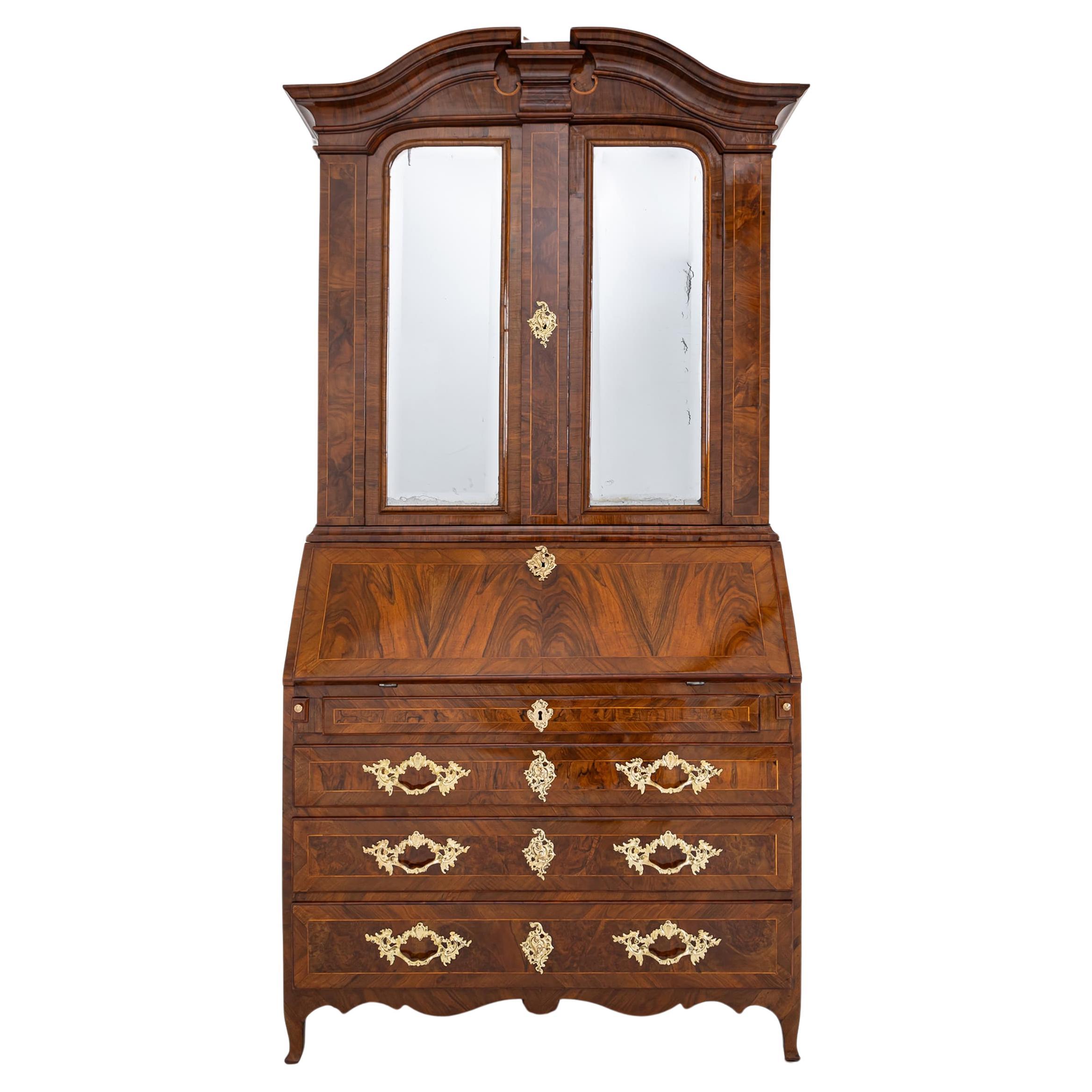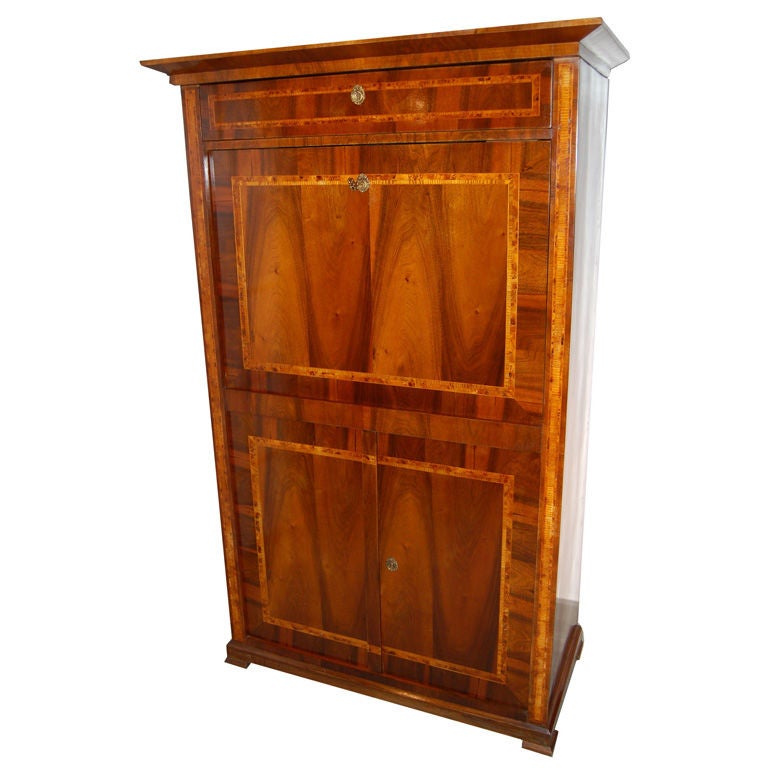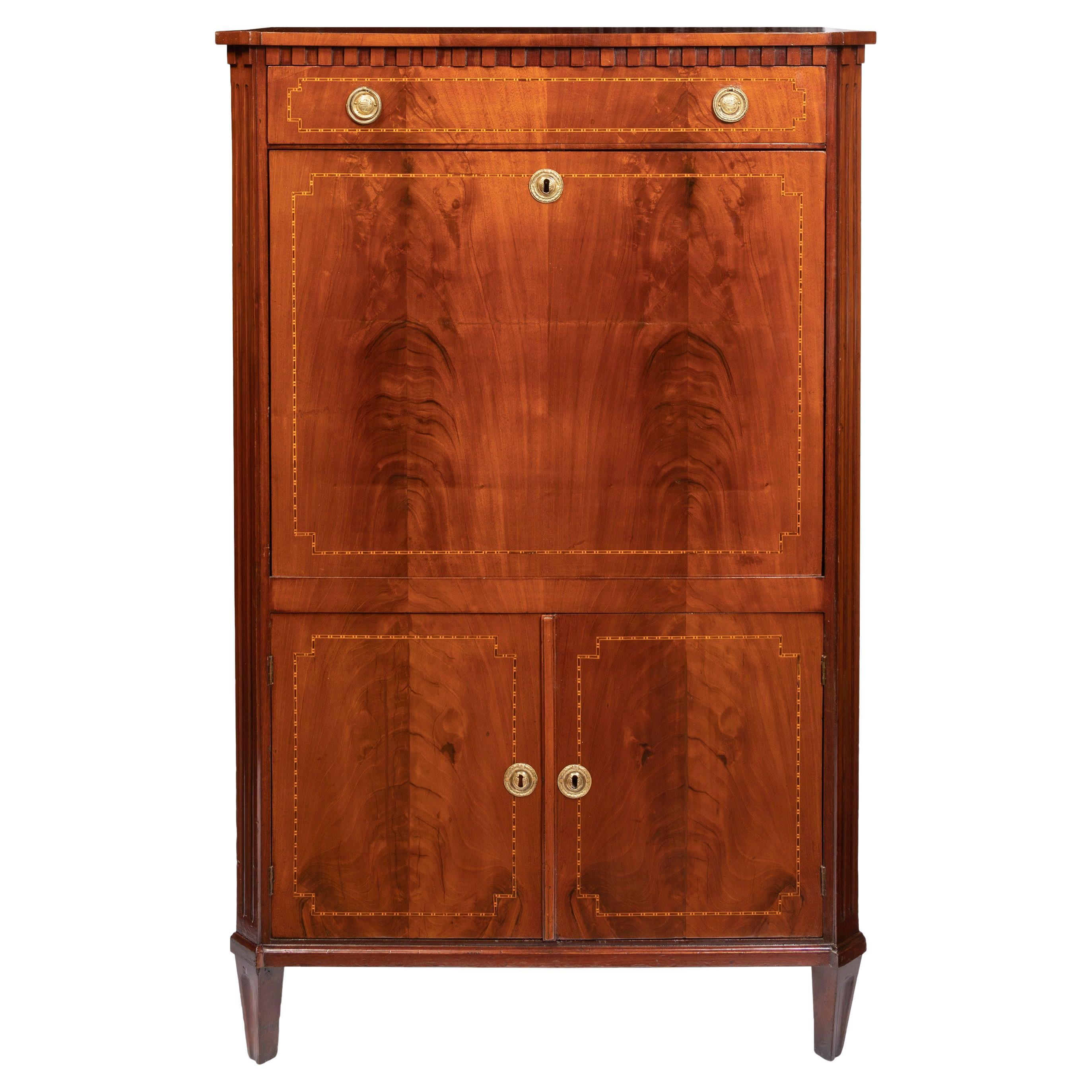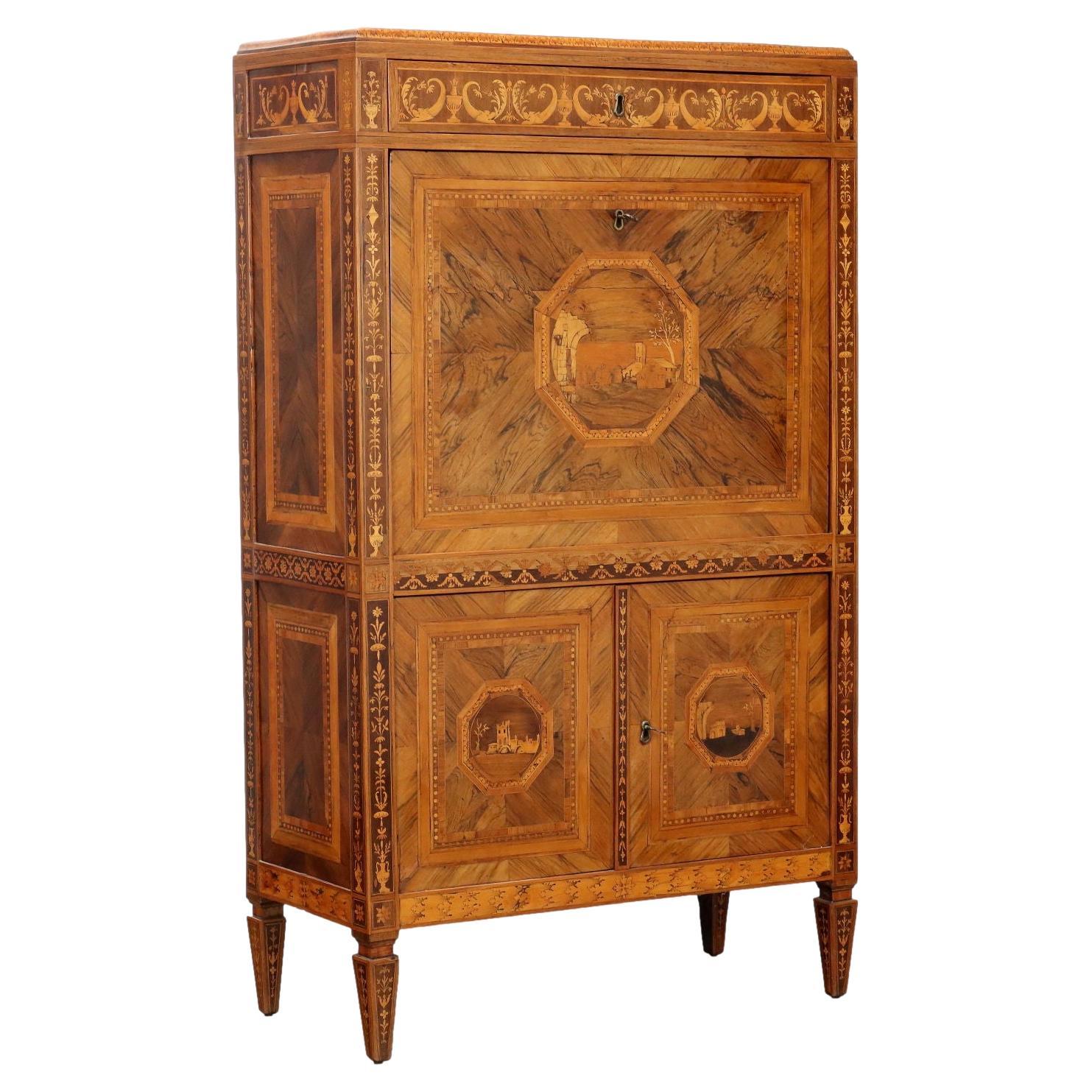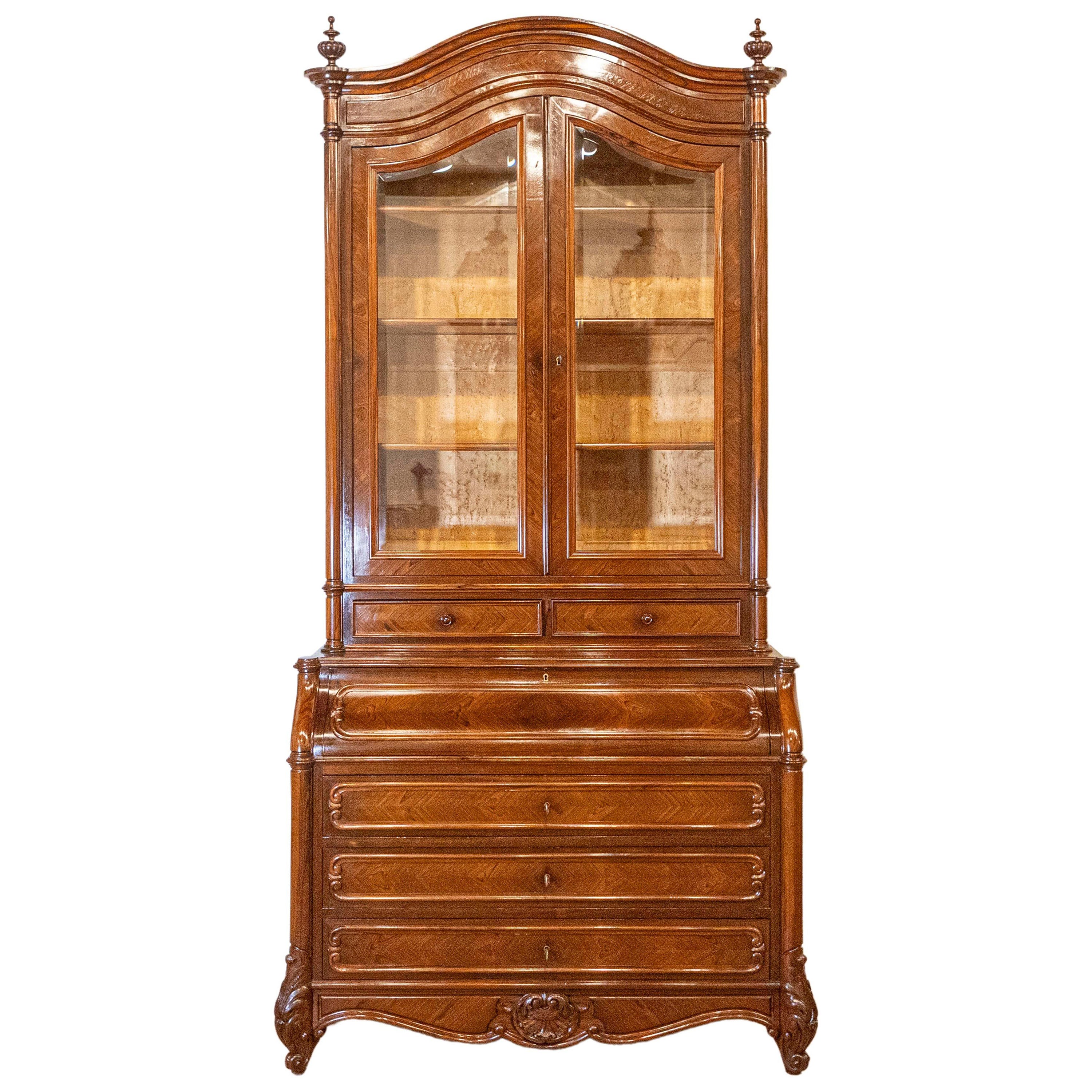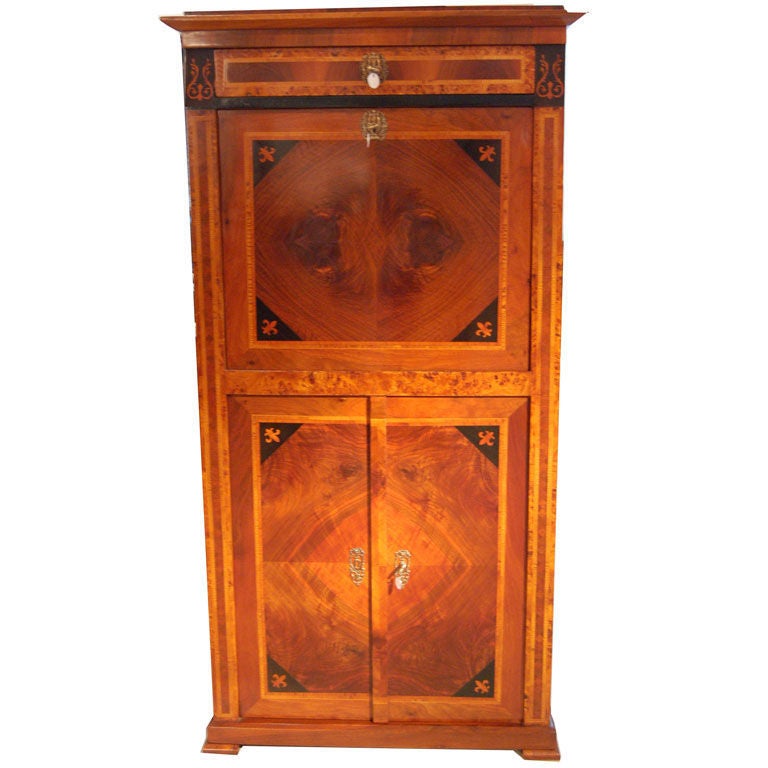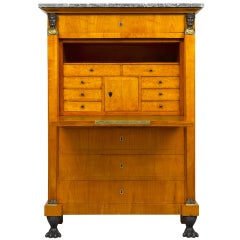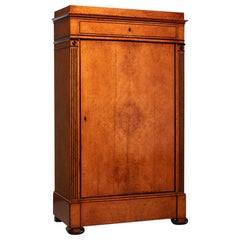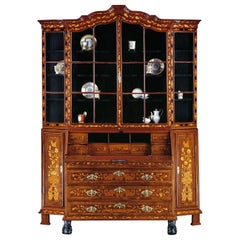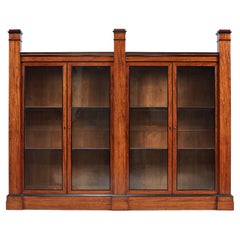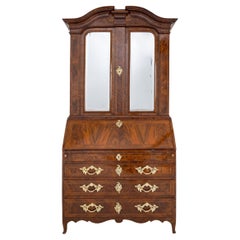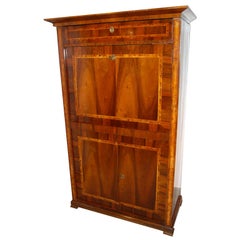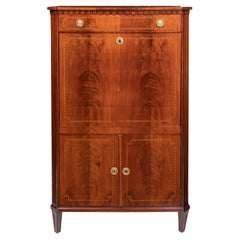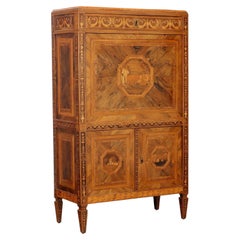Items Similar to Important Early 19th Century Danish Neoclassical Secretaire NIcolai Abildgaard
Want more images or videos?
Request additional images or videos from the seller
1 of 8
Important Early 19th Century Danish Neoclassical Secretaire NIcolai Abildgaard
$35,172.41
£26,057.48
€29,500
CA$48,184.45
A$53,464.71
CHF 28,005.96
MX$655,620.83
NOK 356,226.21
SEK 336,262.34
DKK 224,400
Shipping
Retrieving quote...The 1stDibs Promise:
Authenticity Guarantee,
Money-Back Guarantee,
24-Hour Cancellation
About the Item
The slender secretaire on an unusual high stand with four curved legs dived into quarters, the frame with a central inlaid palmette motif. The fall down writing flap, enclosing a fitted interior with numerous drawers, above and below are two doors enclosing one shelf. The top of the secretaire in form of a classical triangular pediment, the center of which is decorated with an inlaid stylized anthemion. The entire front is very plain and geometrical, divided into six panels inlaid with rectangular fields in light wood.
The design of this mahogany secretaire is based on classical Roman and Greek models, in this case the bookcases that were portrayed on frescoes, reliefs and Roman gold glass. As secretaires were not known in Antiquity, Abildgaard designed his secretaire as a cupboard though in such a way, that the two centre doors are actually a fall front writing top. The carved turned underframe is inspired by Etruscan footstools, which were known especially from reliefs and had been reproduced in contemporary prints. Abildgaard designed this piece of furniture far more in accordance with ancient tradition than did the other furniture designer of the day. The most important (and avantgarde) piece of the furniture Abildgaard designed in the first decade of the 19th century, is this secretaire, which marks a real renewal in relation to the secretaires that constituted the master's test for the members of the guild of cabinetmakers at this time. Compared with these, this secretaire is a very light piece of furniture that does not follow the contemporary fashion towards classical architectural decorations such as columns, pillars, architraves, etc. which often endow such pieces.
Nicolai Abraham Abildgaard (11 September 1743 – 4 June 1809) was a leading Danish Neoclassical painter who also designed (mostly for his own use) elegant Grecian furniture. Some of the pieces were quite archaeologically accurate, being copied from 5th-century BCE vases and decorated with painted panels imitating red figure vase painting. He also designed furniture for Crown Prince Christian Frederick of Denmark. He was strongly inspired by his travels to Rome, where he stayed from 1772 to 1777. He also took a trip to Naples in 1776 with Jens Juel. In addition to his studies of genre and history paintings he was also interested in other artistic disciplines, like architecture, wall paintings and decorative arts and expanded his knowledge of mythology, antiquities and anatomy.
In his 1961 short film Danish Design, Jørgen Roos tells how in the late 18th century the Danish artist Nicolai Abildgaard travelled to Greece and Italy in search of inspiration from classical art, and came back not only with artistic impetuses, but with classical furniture concepts he began to reproduce: “Abildgaard had become Denmark’s first furniture designer”.
Danish artists’ furniture from the early 19th century – The Dream of a Golden Age
The so-called Danish artists' furniture originated in the 19th century, when it was not uncommon for artists to work in more than one field. As a result, many artists also designed and decorated furniture, often being inspired by antiquity when designing their furniture. At the end of the 18th century, Europe was strongly influenced by the excavations in the ancient cities of Herculaneum and Pompeii, which had a great impact thanks to the illustrated excavation reports. Copies of the furniture of ancient Greece and Rome increasingly appear in the homes of polite society across Europe. In France, it was the cabinetmaker George Jacob and his sons among others, who created furniture after the antique, in London it was Thomas Hope and later in Germany, it was Karl Friedrich Schinkel. This period in Denmark is known as the first "Golden Age" and was dominated by the works of Nicolai Abildgaard, Gottlieb Bindesbøll, and H.E. Freund who were designers of furniture and interiors in the Pompeiian style.
Provenance:
•Private collection of art historian Hans Edvard Nørregaard-Nielsen (1945–2023) .
•Auction Bruun Rasmussen, 1987; no. 499, Lot 1091, from the collection of descendants of Friedrich Tutein
•commissioned (as a pair) by the Danish merchant and shipowner Johann Friedrich Tutein (1757 – 1853) for his newly built townhouse on the corner of Vimmelskaftet and Badstuestræde in Copenhagen
Literature:
• Bregnhoi, Line/ Raabyemagle, Hanne, Abildgaard som Arkitekt – former og farver, 2019.
• Gelfer-Jørgensen, Mirjam, Herculaneum paa Sjælland, Klassicisme og nyantik i dansk møbeltradition, 1988.
• Gelfer-Jørgensen, Mirjam, The Dream Of A Golden Age, Danish Neo-Classical Furniture 1790-1850, 2004.
• Swane, Leo, Abildgaard, Arkitektur og Dekoration, Copenhagen, 1926.
• Waagepetersen, Christian, Danske Møbler før 1848, Copenhagen, 1980, p. 423, fig. 557.
- Creator:Nicolai Abildgaard (Designer)
- Dimensions:Height: 75.6 in (192 cm)Width: 34.26 in (87 cm)Depth: 14.97 in (38 cm)
- Style:Neoclassical (Of the Period)
- Materials and Techniques:
- Place of Origin:
- Period:
- Date of Manufacture:1801-1802
- Condition:Wear consistent with age and use.
- Seller Location:Worpswede / Bremen, DE
- Reference Number:Seller: 33671stDibs: LU981440210332
About the Seller
5.0
Recognized Seller
These prestigious sellers are industry leaders and represent the highest echelon for item quality and design.
Established in 1979
1stDibs seller since 2013
27 sales on 1stDibs
Typical response time: 1 to 2 days
- ShippingRetrieving quote...Shipping from: Worpswede / Bremen, Germany
- Return Policy
Authenticity Guarantee
In the unlikely event there’s an issue with an item’s authenticity, contact us within 1 year for a full refund. DetailsMoney-Back Guarantee
If your item is not as described, is damaged in transit, or does not arrive, contact us within 7 days for a full refund. Details24-Hour Cancellation
You have a 24-hour grace period in which to reconsider your purchase, with no questions asked.Vetted Professional Sellers
Our world-class sellers must adhere to strict standards for service and quality, maintaining the integrity of our listings.Price-Match Guarantee
If you find that a seller listed the same item for a lower price elsewhere, we’ll match it.Trusted Global Delivery
Our best-in-class carrier network provides specialized shipping options worldwide, including custom delivery.More From This Seller
View AllSwiss Early 19th Century Empire Bureau Cabinet, Signed Hirschgartner
Located in Worpswede / Bremen, DE
This fine Empire drop-front secretary (secrétaire a'abattant or secrétaire en armoire) with a writing and standing desk is signed M. Hirschgartner. Hans Martin Hirschgartner (1766-18...
Category
Antique 19th Century Swiss Empire Secretaires
Materials
Marble
Architectural Early 19th Century German Biedermeier Cabinet
Located in Worpswede / Bremen, DE
A very rare and elegant Biedermeier cabinet of architectural form. Very simple in design with a fantastic and warm burr-ash veneer, accentuated with ebonized thread inlay, discs and ...
Category
Antique Early 19th Century German Biedermeier Cabinets
Materials
Ash, Fruitwood
Early 19th Century Dutch Floral Marquetry Bureau Display Cabinet
Located in Worpswede / Bremen, DE
The moulded cornice above two shaped glass panelled doors opening to shelves, the lower part with a hinged sloping fall front opening to reveal a fitted interior with a central door ...
Category
Antique 19th Century Dutch Neoclassical Secretaires
Materials
Ormolu
$7,749 Sale Price
51% Off
Rare French Empire Mahogany Bookcase Library Jacob Desmalter
By François-Honoré-Georges Jacob-Desmalter
Located in Worpswede / Bremen, DE
Large and very unusual French Empire bookcase in beautifully figured mahogany veneer. Four glazed doors (original glass), interior with original shelves (two on each level allow an adjustment for larger...
Category
Antique Early 19th Century French Empire Bookcases
Materials
Mahogany
Unusual German Neoclassical Cabinet with Faux-Book Spine Decorated Door
Located in Worpswede / Bremen, DE
An unusual and decorative cabinet of architectural form with one faux-book spine decorated door, enclosing two shelves. The stepped pediment with one drawer veneered with burl wood a...
Category
Antique Early 19th Century German Neoclassical Cabinets
Materials
Metal
Fine and Impressive Late 18th Century Neoclassical Mahogany Library Bookcase
Located in Worpswede / Bremen, DE
Mahogany, solid and veneered on oak. Openwork gallery above two doors with wire-mesh panelling, the inside with an arrangement of adjustable shelves, retaining two gilt brass escutch...
Category
Antique Late 18th Century Dutch Neoclassical Bookcases
Materials
Brass
$53,652 Sale Price
30% Off
You May Also Like
Baroque Secretaire, Saxony Mid-18th Century
Located in Greding, DE
An elegant Baroque secretary cabinet from Saxony, crafted in the mid-18th century. The lower section consists of a three-drawer commode with a curved apron and S-shaped legs. Above, ...
Category
Antique Mid-18th Century German Baroque Secretaires
Materials
Walnut
Biedermeier Secretaire
Located in Pompano Beach, FL
Biedermeier Secretaire made of walnut, root wood and ebonized wood with fall-front writing surface, interior drawers and secret compartments.
Category
Antique 19th Century Secretaires
Materials
Wood
$9,500 Sale Price
67% Off
19th Century "Secretaire Abattant" Style Standing Drop Front Desk
Located in Madrid, ES
A striking 19th century "Secretaire Abattant" style standing desk with a drop front writing surface. A handsome and functional piece of furniture with copious storage space. It features dramatic wood grain patterns, and fine geometric marquetry fillets of alternating light and darker woods. The interior has ample slots and shelving for display of personal items, and the original leather writing pad...
Category
Antique 19th Century British Secretaires
Materials
Hardwood
$5,365 Sale Price
25% Off
Secretaire intarsiato lombardo Neoclassico XVIII secolo
By Non-Standard Furniture and Lighting
Located in Milano, IT
Secretaire neoclassico realizzato alla fine del XVIII secolo. Realizzato con due ante nella base, anta a ribalta con scarabattolo e cassetto sotto piano. Realizzato in noce e poi imp...
Category
Antique 18th Century Italian Neoclassical Revival Secretaires
Materials
Walnut
Italian Renaissance revival Bookcase Secretaire, 19th Century
Located in Atlanta, GA
This exquisite 19th-century Italian bookcase exemplifies the Renaissance Revival style with its masterful craftsmanship and elaborate design. The bookcase features beautifully hand-c...
Category
Antique 19th Century Italian Renaissance Revival Bookcases
Materials
Glass, Walnut
Biedermeier Secretaire
Located in Pompano Beach, FL
Bureau Secretaire, Biedermeier. Walnut, birdseye, rootwood, intarsia, secret compartments.
Category
Antique 19th Century Secretaires
$11,500 Sale Price
57% Off
More Ways To Browse
19th Century Artist Model
Grecian Furniture
Maples London
Danish Painting 19th Century
Danish Neoclassical
Danish Paintings Of The 19th Century
Red Figure Vases
Greek Red Figure
Roman Pillar
Design Guild Glass
French Neoclassical Prints
End Of The Day Vase
Pillar Vase
Roman Thomas Furniture
Roman Thomas
Corner Cabinets Pair Mahogany
18th Century Danish Cabinet
Antique Mahogany Wall Cabinet
